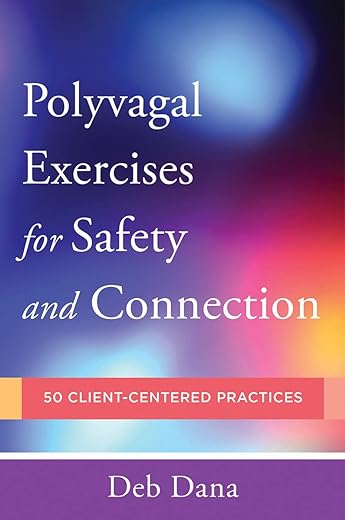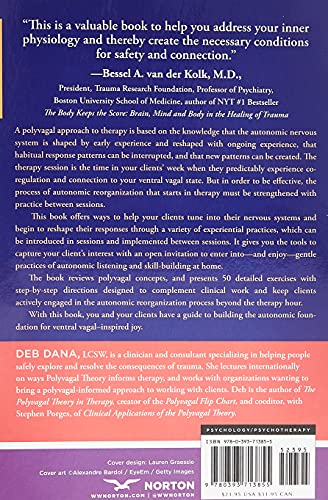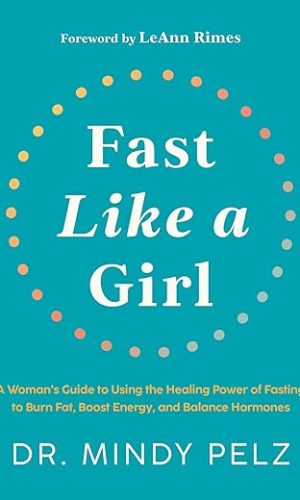Polyvagal Exercises for Safety and Connection: 50 Client-Centered Practices (Norton Series on Interpersonal Neurobiology)
£14.20
Deb Dana is the foremost translator of polyvagal theory into clinical practice. Here, in her third book on this groundbreaking theory, she provides therapists with a grab- bag of polyvagal-informed exercises for their clients, to use both within and between sessions. These exercises offer readily understandable explanations of the ways the autonomic nervous system directs daily living. They use the principles of polyvagal theory to guide clients to safely connect to their autonomic responses and navigate daily experiences in new ways. The exercises are designed to be introduced over time in a variety of clinical sessions with accompanying exercises appropriate for use by clients between sessions to enhance the therapeutic change process. Essential reading for any therapist who wants to take their polyvagal knowledge to the next level and is looking for easy ways to deliver polyvagal solutions with their clients.
Read more
Additional information
| Publisher | W. W. Norton & Company (21 April 2020) |
|---|---|
| Language | English |
| Paperback | 304 pages |
| ISBN-10 | 0393713857 |
| ISBN-13 | 978-0393713855 |
| Dimensions | 13.97 x 2.29 x 20.83 cm |











by Breindy Gold
Great book
by Tracy Wilson
The information is clear and concise and a great resource to assist client work.
by David McGough
A very educative and soothing book of connecting truly shattered and overwhelmed autonomic nervous systems towards empathetic communication and to care for brutally overwhelmed bodies in 50 exercises that are very palatable and translatable – I live a truly profound height of C-PTSD & Severe M.E and have not had Polyvagal Therapy before and on listening to the audio it felt to hopefully be a very effective technique to the armory of a trauma survivor to find or want to seek a Neuro-Ception of Safety Co-Regulation Relaxation Spaciousness & Equanimity. I have been made to lose complete contact with my body so when trauma is stored physically giving back to our bodies through this type of technique is so important talking of Autonomic trees and Glimmers Glows into Long Glows and Finding Awe – I found this very understandable and full of the best intentions and never overly intellectualizing but finding a language to regulate our lost nervous systems trapped in sympathetic dorsal and rarely in ventral vagal – heartbreakingly in protection mode and trying to find a balance a present-day and a way forward that can overtime hopefully re-wiring our bodies our expectations from such a fear-driven past/present.
by Dee
I love how Deb Dana has made polyvagal theory, and exercises to promote safety and connection so accessible, another wonderful contribution to the world
by schmintan
It’s an interesting read, but quickly it starts providing lists and lists of “tools” to help a person identify their polyvagal state.
The sheer number of methods and tools are overwhelming and as someone who experiences severe anxiety, I haven’t found it of much use.
Perhaps it’s better for a therapist, who sees lots of clients and needs a diverse set of tools, depending on each client.
by Ms. J. Collier
I purchased this to help use polyvagal theory in my work with an autistic PDA student. I also purchased “The Polyvagal Theory in Therapy: Engaging the Rhythm of Regulation” and I would suggest only buying this book rather than both if you know a little about polyvagal theory already. The other book covered very similar content but was more explanatory whereas the 50 exercises book was far more practical.
I use this book’s techniques every day to calm myself down with my own children – it suggests doing the exercises yourself first so I did and it really helped me personally which was unexpected. If you want help but can’t afford therapy then this would be a good thing to read as long as you are willing to put the work in yourself to do the exercises.
There are 50 and you don’t need to do them all but it might be worth putting a recurring calander event in so you do one per week/two per week so the book doesn’t end up gathering dust on your shelf.
I did some with my husband and discussed them afterwards which was really lovely and felt very safe and a lovely bonding activity (e.g imagining your polyvagal tree and seeing how ours differed, which helped us to understand each other more).
This book has also been really helpful at work so to sum up – if you’re on the fence, purchase it!
by Margar
An excellent book that brings to life the Polyvagal Theory in the context of healing and therapy.
by Amazon Customer
Im nibbling slowly – no complaints. Yes, I would recommend for people taking it really slowly.